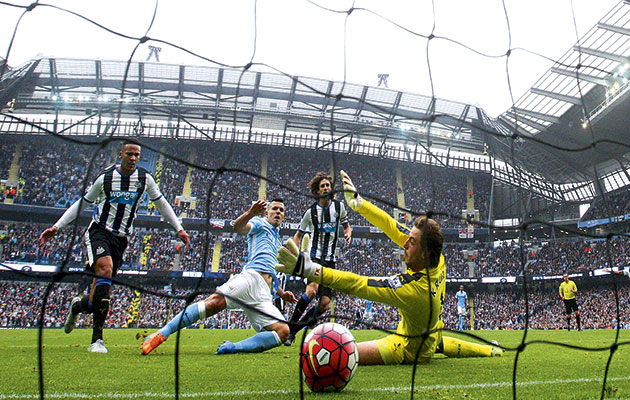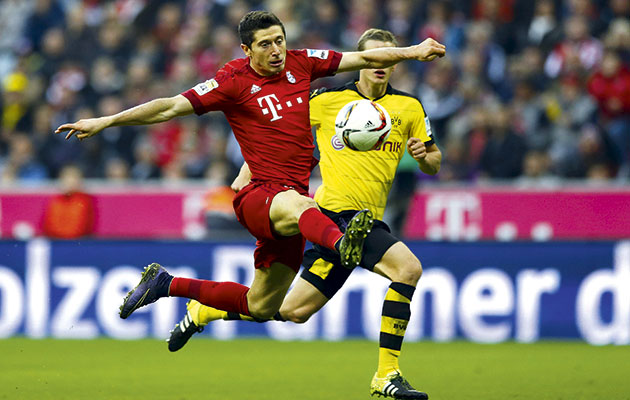Arsene Wenger’s irritation at being asked again and again why he didn’t sign a striker in the summer has been obvious, but his answer has rarely varied. He didn’t sign a striker for the very simple reason that there wasn’t one available.
Or at least, there wasn’t one available that he could guarantee would be better than Theo Walcott and Oliver Giroud, and who would fit in with his economic principles – which meant not splashing a potential £58million on a 19-year-old of unproven potential as Manchester United did when they signed Anthony Martial.
Who, after all, could Arsenal realistically have signed? Who could they have got in the £30-50m bracket who would have left whatever club they were with and be guaranteed to score 20 goals a season?
With hindsight, perhaps Wenger should have gone for Pierre-Emerick Aubameyang, but nobody could have foreseen how he started this season in Thomas Tuchel’s free-scoring Borussia Dortmund side.
It may be that the current dearth is a freak, and that over the next five years a vast numbers of gifted goalscorers will emerge, but this feels like a result of the way the game has evolved. Goalpoachers have all but vanished from the game at the highest level as strikers these days need to be multifaceted. They can’t simply hang around the box, or drift off the shoulder of the last defender, or dart across the near post to finish off chances others have crafted for them. They must now also be capable of creating their own opportunities and, perhaps even more significantly, of linking the play.
The two greatest goalscorers of the age, Cristiano Ronaldo and Lionel Messi, are both converted creators: Ronaldo a winger, Messi a number 10 who spent much of his early career playing out wide.
They score more goals than anybody else because they are better than everybody else, but goalscoring is only part of what they do – something that has perhaps affected the thinking about what a centre-
forward should do.
The emergence of the false nine, the striker who occupies the centre-forward position but drops off to become a de facto number 10, creating space for wide men or runners from midfield, has redefined what it is to be a striker. And the success of that style of forward has had ramifications down the game.
There is, however, a certain irony in the fact that the best classical striker in the game at the moment, Bayern Munich’s Robert Lewandowski, is prospering under a coach who, in his time at Barcelona, did most to refine the position out of existence: Pep Guardiola.
Lewandowski first made a name for himself in the Bundesliga at Dortmund, playing as a second striker behind Lucas Barrios. Although the Pole’s physical strength, finishing and willingness to work across the front line gives him the appearance of an old-school number nine, there is something of Ian Rush about him in look, manner and style, but he has a wider range of skills than was traditional and can create if need be.
That, in a sense, makes him ideal for the Bayern system. Lewandowski’s movement and touch are good enough to join in the rat-a-tat of passing that is characteristic of the Guardiola style.
But he is also different enough to add a physical edge and has the sort of lethal finishing that both makes Bayern’s build-up play even more dangerous than it is anyway, and means he might nick a goal from nothing to salvage a game that had been going against Bayern – not that there have been many of those this term.
It was his five goals in nine minutes for Bayern against Wolfsburg in September that made headlines, but the header he scored for Poland against the Republic of Ireland a couple of weeks later was more emblematic of what makes him so hard to play against – darting across his marker to meet a cross with a ferocious powerful header that was proof of his ability to guide the ball goalwards at extreme force from almost anywhere in the box.
In a very different way, Lewandowski has done for Bayern what Diego Costa did for Chelsea last season and for Atletico Madrid before that. He is somebody who turns pressure into chances, picking up on the slightest sniff of a chance in the box while at the same time fitting into the general pattern of play.

Finisher…Sergio Aguero scores his fifth goal in Manchester City’s 6-1 victory over Newcastle United in October
In January, Wenger made the point that the best strikers all seem to come from South America, highlighting Costa, Sergio Aguero and Alexis Sanchez.
“If you look across Europe, where are the strikers from?” he asked. “You will see that many of them – at least 80 per cent – come from South America. So we have to question ourselves: what can we add to our academies to develop strikers again?
“If you look at the 60s, 70s in England, even when I arrived in 1996, in every club you had strikers – and I mean strikers: those who could head the ball. We have less now. In Germany they went to the World Cup with [Miroslav] Klose, who is 35.
“Maybe in our history, street football has gone. In street football, when you are 10-years old you play with 15-year-olds, so you have to be shrewd, you have to show that you are good, you have to fight, win impossible balls. When it is all a bit more formulated then it is developing your individual skill, your fighting attitude less. We have lost a little bit of that in football.”
Yet Sanchez and Aguero are not typical centre-forwards; they are finishers who can come from deep or wide. Sanchez, in particular, seems to need a left-sided starting berth, which he has with both Arsenal and Chile. That suggests it’s not just about his street origins, but also an issue of shape.
Tactical evolution and developmental evolution seem to have created a world in which the striker is a rare breed.







